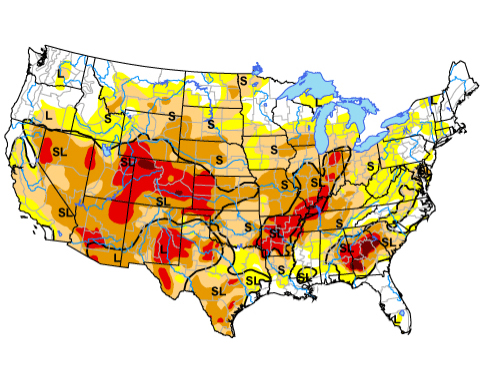
More of the United States is in moderate drought or worse than at any other time in the 12-year history of the U.S. Drought Monitor, researchers from the National Drought Mitigation Center at UNL announced July 12.
Analysis of the latest drought monitor data revealed that 50.92 percent of the nation's land area is in various stages of drought, up from the previous record of 46.84 percent a week ago. Records prior to July 4 were 45.87 percent in drought on Aug. 26, 2003, and 45.64 percent on Sept. 10, 2002.
Looking only at the 48 contiguous states, 60.84 percent of the country's land area is in moderate drought or worse — also the highest percentage on record in that regard, officials said. The previous highs had been 55.96 percent on July 5, 2012 and 54.79 percent on Aug. 26, 2003.
"The recent heat and dryness is catching up with us on a national scale," said Michael J. Hayes, director of the National Drought Mitigation Center. "Now, we have a larger section of the country in these lesser categories of drought than we've previously experienced in the history of the Drought Monitor."
The monitor uses a ranking system that begins at D0 (abnormal dryness) and moves through D1 (moderate drought), D2 (severe drought), D3 (extreme drought) and D4 (exceptional drought).
Moderate drought's telltale signs are some damage to crops and pastures, with streams, reservoirs or wells getting low. At the other end of the scale, exceptional drought includes widespread crop and pasture losses, as well as shortages of water in reservoirs, streams and wells, creating water emergencies. So far, just 8.64 percent of the country is in either extreme or exceptional drought.
"During 2002 and 2003, there were several very significant droughts taking place that had a much greater areal coverage of the more severe and extreme drought categories," Hayes said. "Right now we are seeing pockets of more severe drought, but it is spread out over different parts of the country.
"It's early in the season, though. The potential development is something we will be watching."
The U.S. Drought Monitor is a joint endeavor by the National Drought Mitigation Center at UNL, the National Oceanic and Atmospheric Administration, the U.S. Department of Agriculture and drought observers across the country.
To examine the monitor's current and archived national, regional and state-by-state drought maps and conditions, go to http://droughtmonitor.unl.edu.
— Kelly Helm Smith, Natural Resources and Steve Smith, University Communications
More details at: http://go.unl.edu/ojp